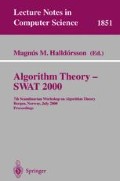Abstract
We apply Lekkerkerker and Boland’s recognition algorithm for triangulated graphs to the class of weakly triangulated graphs. This yields a new characterization of weakly triangulated graphs, as well as a new recognition algorithm which, unlike the previous ones, is not based on the notion of 2-pair, but rather on the structural properties of the minimal separators of the graph. It also gives the strongest relationship to the class of triangulated graphs that has been established so far.
Access this chapter
Tax calculation will be finalised at checkout
Purchases are for personal use only
Preview
Unable to display preview. Download preview PDF.
References
S. Arikati and P. Rangan. An efficient algorithm for finding a two-pair, and its applications. Discrete Applied Mathematics and Combinatorial Operations Research and Computer Science, 31, 1991.
A. Berry. A wide-range efficient algorithm for minimal triangulation. In Proceedings of the Tenth Annual ACM-SIAM Symposium on Discrete Algorithms (SODA’99 ).
A. Berry. Désarticulation d’ungraphe. PhD thesis, LIRMM, Montpellier, France, 1998.
A. Berry, J.-P. Bordat. Minimal separators in a weakly triangulated graph. Res. Rep. LIRMM, April 2000.
A. Berry, J.-P. Bordat and O. Cogis. Generating all the minimal separators of a graph. In Proceedings of WG’99.
A. Berry, J.-P. Bordat and P. Heggernes. Computing a minimal triangulation from an arbitrary ordering. In preparation for journal submission.
V. Bouchitté and I. Todinca. Treewidth and minimum fill-in of weakly triangulated graphs. In LNCS 1563, Proceedings 16th Symposium on Theoretical Aspects of Computer Science ( STACS’99 ). Submitted to SIAM J. Comput.
G.A. Dirac. On rigid circuit graphs. Anh. Math. Sem. Univ. Hamburg, 25:71–76, 1961.
D.R. Fulkerson and O.A. Gross. Incidence matrixes and interval graphs. Pacific Journal of Math., 15:835–855, 1965.
R. Hayward. Weakly triangulated graphs. J. Comb. Theory, 39:200–208, 1985.
R. Hayward. Two classes of perfect graphs. PhD thesis, School of Computer Science, McGill University, 1987.
R. Hayward. Generating weakly triangulated graphs. J. Graph Theory, 21:67–70, 1996.
R. Hayward. Meyniel weakly triangulated graphs-1: co-perfect orderability. Discrete Applied Mathematics, 73:199–210, 1997.
R. Hayward. Meyniel weakly triangulated graphs-2: A theorem of Dirac. Discrete Applied Mathematics, 78:283–289, 1997.
R. Hayward, C. Hoàng, and F. Maffray. Optimizing weakly triangulated graphs. Graphs and Combinatorics, 5:339–349, 1989.
R. Hayward, J. Spinrad, and R. Sritharan. Weakly chordal graph algorithms via handles. In Proceedings of the Eleventh Annual ACM-SIAM Symposium on Discrete Algorithms (SODA’ 2000).
D. Kratsch. The structure of graphs and the design of efficient algorithms. In Habilitation Thesis, Fakultät für Mathematik und Informatik der Friedrich-Schiller Universität Jena, 1995.
C.G. Lekkerkerker and J.C. Boland. Representation of a finite graph by a set of intervals on the real line. Fund. Math., 51(45’64), 1962.
L. Nourine and O. Raynaud, A Fast Algorithm for building Lattices. Information Processing Letters, 71:199–20, 1999.
D. Rose, R.E. Tarjan, and G. Lueker. Algorithmic aspects of vertex elimination on graphs. SIAM J. Comput., 5:146–160, 1976.
J. Spinrad. Finding large holes. Information Processing Letters, 39(4):227–229, August 1991.
J. Spinrad and R. Sritharan. Algorithms for weakly triangulated graphs. Discrete Applied Mathematics and Combinatorial Operations Research and Computer Science, 59, 1995.
I. Todinca. Aspects algorithmiques des triangulations minimales des graphes. PhD thesis, LIP, ENS Lyon, 1999.
Author information
Authors and Affiliations
Rights and permissions
Copyright information
© 2000 Springer-Verlag Berlin Heidelberg
About this paper
Cite this paper
Berry, A., Bordat, JP., Heggernes, P. (2000). Recognizing Weakly Triangulated Graphs by Edge Separability. In: Algorithm Theory - SWAT 2000. SWAT 2000. Lecture Notes in Computer Science, vol 1851. Springer, Berlin, Heidelberg. https://doi.org/10.1007/3-540-44985-X_13
Download citation
DOI: https://doi.org/10.1007/3-540-44985-X_13
Published:
Publisher Name: Springer, Berlin, Heidelberg
Print ISBN: 978-3-540-67690-4
Online ISBN: 978-3-540-44985-0
eBook Packages: Springer Book Archive

